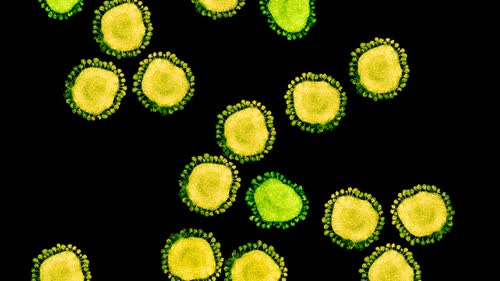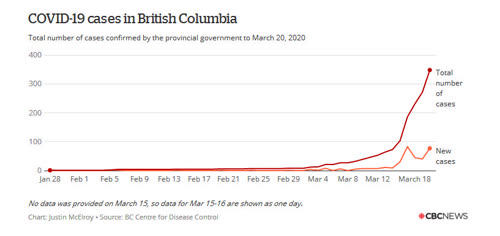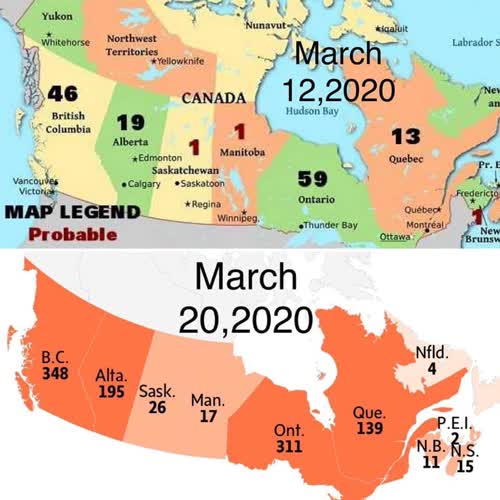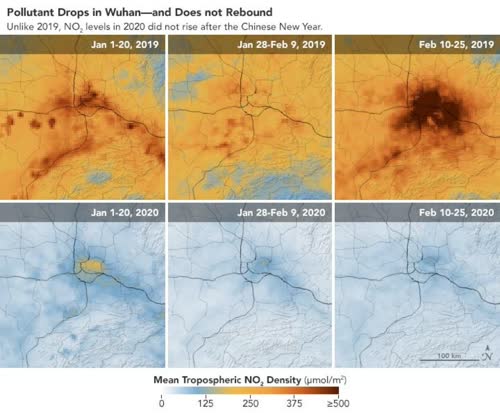|
Why the Coronavirus Has Been So Successful We’ve known about SARS-CoV-2 for only three months, but scientists can make some educated guesses about where it came from and why it’s behaving in such an extreme way. |
|
B.C. announces 77 new coronavirus cases, bringing total to 348, as restaurants close province-wide All restaurants in B.C. now being ordered to move to take-out and delivery models only.
|
|
City in Shutdown
|
|
Air pollution drops as countries shut down amid spread of COVID-19 Large drops of nitrogen dioxide seen over Italy and China
|
|
Sobeys to install plexiglass barriers at checkouts as grocers work to stay open amid coronavirus outbreak Sobeys parent company Empire Co. Ltd. has ordered thousands of plexiglass screens to be installed at store checkouts in an effort to provide some separation between staff and customers.
|
|
Trump's 'Chinese' Virus Is Part of a Long History of Blaming Other Countries for Disease
Even as his Administration’s response to COVID-19 has evolved, one part of President Donald Trump’s reaction to coronavirus has remained consistent. More than a week after he prompted outcry by retweeting a supporter who called the novel coronavirus the “China virus,” photos from Trump’s Thursday press briefing about the virus showed that “corona” had been crossed out and replaced with “Chinese.” The President and his team have defended the use of that language—despite the World Health Organization making a point of not naming the disease after the place where the outbreak began, and despite advocates arguing that such terminology fuels the risk of hate crimes against people of Asian descent, who have already reported a surge in discrimination. Take the so-called “Spanish flu,” a pandemic in 1918 and 1919 that killed up to 50 million people worldwide. Many Americans, including Republican Senator Chuck Grassley, seem to believe—as the name implies—that this influenza outbreak began in Spain. However, the first recorded case was in Kansas. (Meanwhile in Spain, it was known as the “French flu.”) Just a couple of years before the 1918 flu outbreak, Italian immigrants on the East Coast were blamed for a polio outbreak, though in fact there was no evidence of an outbreak either in Italy or at Ellis Island. And for decades, white Americans associated Chinese immigration with a host of diseases, and used public health as an excuse to discriminate against them. “America has a long history of immigrant exclusion on the basis of disease,” says Kim Yi Dionne, a professor of political science at the University of California-Riverside who has written about how politicizing disease can shape public attitudes about immigration. “Chinese immigrants to California were treated as medical scapegoats for years, and their exclusion based on disease threat was actually codified in the 1882 Exclusion Act.” Cholera was sometimes called “Asiatic cholera” because it was first detected in India, even though it also flourished in European countries like Britain. As for smallpox, it had originally come to the Americas through European invasion. Together with other new infectious diseases, smallpox killed millions of Native people. This biased way of associating immigrants with disease continued throughout the 20th century. A 1957-58 flu pandemic that was first identified in China became known as the “Asian flu,” and a 1968-1969 flu pandemic first identified in Hong Kong became known as the “Hong Kong flu.” Yet the 2009-2010 H1N1 flu that the CDC says was first recorded in the U.S. didn’t become the “American flu.” Instead, it gained the misleading name “swine flu” because scientists at first thought it was similar to viruses that occur in North American pigs, although further testing has complicated this theory. Much of the media coverage around this flu emphasized that it may have come from Mexico, which had by then become the focus of American immigration anxiety. In fact, many Americans still seem to think of H1N1 as a foreign virus. On Wednesday, Republican Senator John Cornyn falsely claimed China was the source of “swine flu.” |






